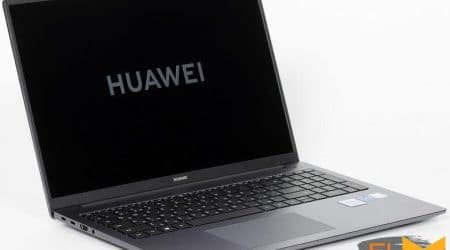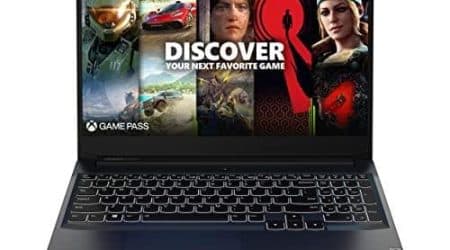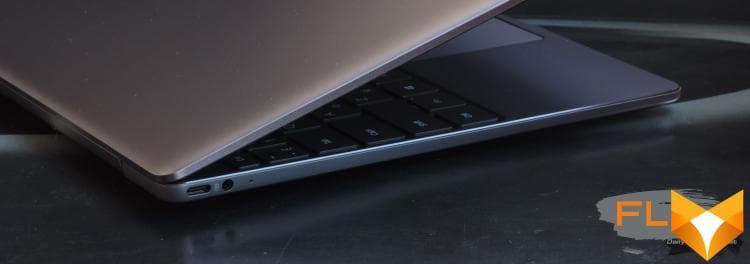


Choosing a hardware platform for the next upgrade of the MateBook series, the Chinese giant did not limit itself and released two versions of the same device at once: one based on the 10th generation Intel Core, the other on Ryzen chips. And so as not to be confused, the “red” laptop is called: MateBook 13 AMD. The time when Advanced Micro Devices processors, despite their merits, came across only in frankly budget products is behind us, and the new product perfectly illustrates the changes that have taken place.
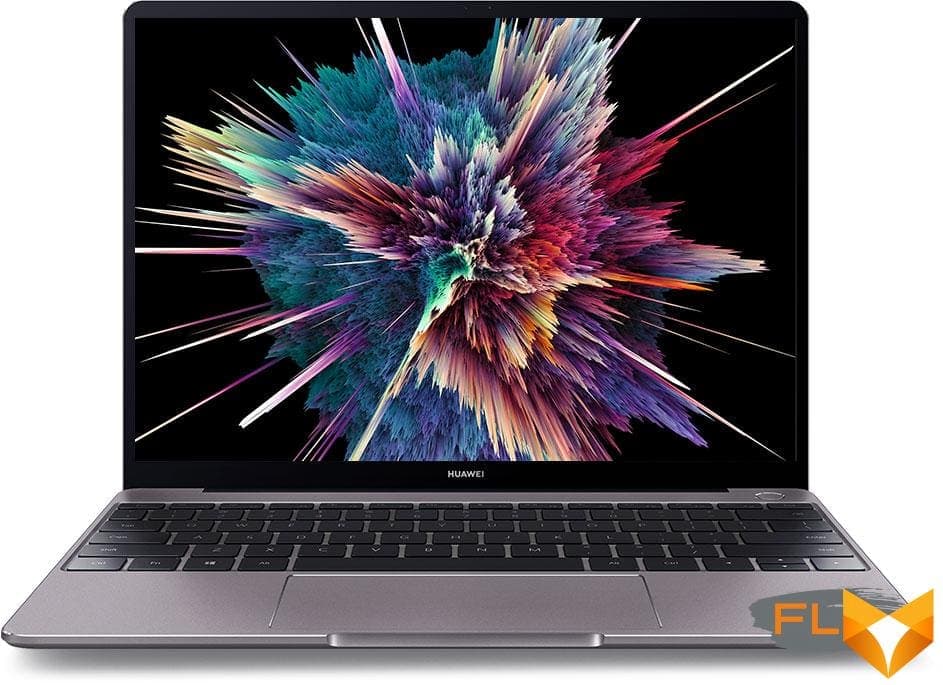
⇡#Specifications, prices
Before we talk about AMD’s MateBook 13 specs, let’s face the disappointing fact: HUAWEI didn’t have time to use the latest Ryzen 4000-series processors with Zen 2 cores manufactured at 7nm. All possible configurations of the novelty are equipped with a 12-nanometer chip of the previous generation Ryzen 5 3500U. However, this is still an actual offer that perfectly suits ultra-compact laptops in terms of its performance: four cores and a clock speed range of 2.1 to 3.7 GHz within a 15W thermal package. Last but not least, Ryzen-based systems boast a very serious integrated graphics core – in this case, it is the Radeon Vega 8 with eight Compute Units. Thanks to powerful integrated graphics, HUAWEI was able to dispense with a separate GPU, while its sister model, the MateBook 13, powered by Intel with 10th Gen Core i5/i7 processors, received NVIDIA’s entry-level discrete graphics adapter, the GeForce MX250.
| Manufacturer | HUAWEI |
|---|---|
| Model | MateBook 13 AMD |
| Display | 13″, 2160 × 1440, IPS |
| CPU | AMD Ryzen 5 3500U (4/8 cores/threads, 2.1-3.7GHz) |
| RAM | DDR4 SDRAM, 3733 MT/s, 8/16 GB (dual channels) |
| GPU | AMD Radeon Vega 8 (1 GB of system RAM) |
| Drive | WD PC SN730 (PCIe 3.0 x4) 256/512 GB |
| External I/O connectors | 2 × USB 3.2 Gen 1 Type-C; 1 x TRS 3.5mm |
| Network | IEEE 802.11ac + Bluetooth 5.0 |
| Battery capacity, Wh | 41.8 Wh |
| Weight, kg | 1.31 |
| Overall dimensions (L × H × D), mm | 286 × 211 × 14.9 |
| Retail price | From 1000$ (16 GB, 512 GB) |
The MateBook 13 sold in Russia with an Intel processor has 8 GB of LPDDR3 2133 MHz system memory, and with AMD it has faster DDR4 chips with a bandwidth of 3733 MT / s, and even more, at 16 GB. There is only one storage capacity – it is a 512 GB NVMe SSD. Terabyte equipment, unfortunately, is not provided.
In terms of SSD volumes, you can already guess that the MateBook 13 is not aimed at the “premium” price segment. Indeed, exactly the same configuration that came to us for testing (Ryzen 5 3500U, 16 GB of RAM and half a terabyte of ROM) is available in Russian online stores for 1000$, and the Intel counterpart (Core i5-10210U, 8 GB of RAM and GeForce MX250) is a little more expensive – about 1200$. For that kind of money, you can’t buy either a fresh MacBook Air (even with a dual-core Core i3), or an advanced working ultrabook under another famous brand (such as ASUS ExpertBook B9). As a result, HUAWEI had to save on something, but, as we will now find out, the developers of the MateBook 13 had completely different priorities than their many Taiwanese counterparts.
⇡#Look and feel
HUAWEI designers still shamelessly copy the style of the products of one well-known company. If it were not for the letters on the lid instead of an apple, and even the case is thicker and a slightly different shape of the edges, the MateBook 13 could easily be mistaken for a MacBook Air. They even have the same colors – silver or space gray. Who is who will only show the “MacBook test” (that is, an attempt to raise the screen with one hand), which the MateBook 13, no, did not pass.
But if the first attempts of the Chinese to imitate Apple could be ironic, now someone in Cupertino is not laughing. Neither the quality of the case materials, nor the mechanics of the MateBook 13 is completely inferior to its inspirer. While other manufacturers compete for minimum weight, neglecting the strength of the chassis, HUAWEI agreed to make the laptop heavier – it weighs 1.31 kg, but it gives the impression of a monolithic product: even the screen is not so easy to bend by pulling the corners in different directions, and the keyboard and touchpad (the eternal disease of other ultra-compacts) lie on a solid foundation. The only blot – and we can say that the design feature of the MateBook 13 – is that the lower half of the case is assembled not from two panels (a sheet around the keyboard and the bottom), but from three. The edging with slots for the connectors is a separate part, well fitted to the neighboring ones.

But, perhaps, comparing the MateBook 13 with the modern MacBook Air is not entirely correct. Most of all, it looks like a “just” MacBook with a 12-inch screen, which Apple later recognized as a dead end branch of evolution, but HUAWEI remained unconvinced, and, judging by the results, not in vain. Dimensions The MateBook 13 sets a screen with a diagonal of exactly 13 inches and a 3:2 aspect ratio, which is even rarer than Apple’s favorite 16:10 panels. After the typical proportions of 16:9, such a screen is like a breath of fresh air, it makes the short diagonal so much more convenient. And it’s not just subjective impressions. The screen area of the MateBook 13 is 503.22 cm2. For comparison: the prevailing 13.3-inch Full HD matrices on the market have only 487.64. The MacBook Air has a slightly larger screen (512.91 cm2), but the American itself is larger in width, and takes up almost as much space in depth due to the high frames.

3:2 proportions correspond to a special resolution, and in addition, HUAWEI did not fail to increase the pixel density: dimensions of 2160 × 1440 with a diagonal of 13 inches give 199.69 dpi. This is not yet “retina” (226.98 for the MacBook Air), but it is already quite close, and most importantly, enough to smooth out fonts and program interfaces. Finally, the matrix here is very bright, but packed under glass, which seems to be not protected from glare in any way and turns into a real mirror in bright daylight. The oleophobic coating is weak, fingerprints are excellent.
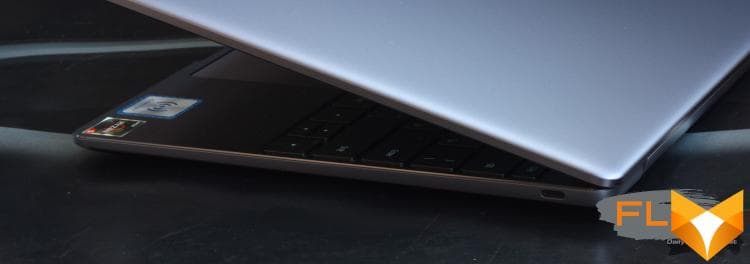
The mediocre oleophobic and anti-reflective coating is the first sign of savings. The second is a set of external interfaces, which comes down to two USB Type-C and a mini-jack for connecting an audio headset. “Wait, because Apple does exactly the same!” – the one who missed the table with the technical characteristics of the MateBook 13 will say. The fact is that MacBooks, although not rich in connectors, support the Thunderbolt 3 standard, which allows you to use one socket for all needs – charging, displaying images and high-speed communication with powerful peripherals (eGPU and DAS). The MateBook 13 only has USB 3.1 Gen 1, and each of the two ports has its own limitations: the power provided by the compact 65-watt regulator can only come from the left, while the signal to the monitor goes from the right. The laptop comes with an adapter through which you can power the device and connect something else at the same time, but you won’t be able to use the HDMI and VGA outputs, which are also on the adapter. As a result, in any case, users of external screens will only have one free USB connector – on the adapter in the right position.
The third reminder that the new HUAWEI is, whatever one may say, an offer for the masses, was the sound of the built-in speaker system. The MateBook 13’s stereo speakers are not only quiet, which is natural for a modest case, but also resonate at high volumes.
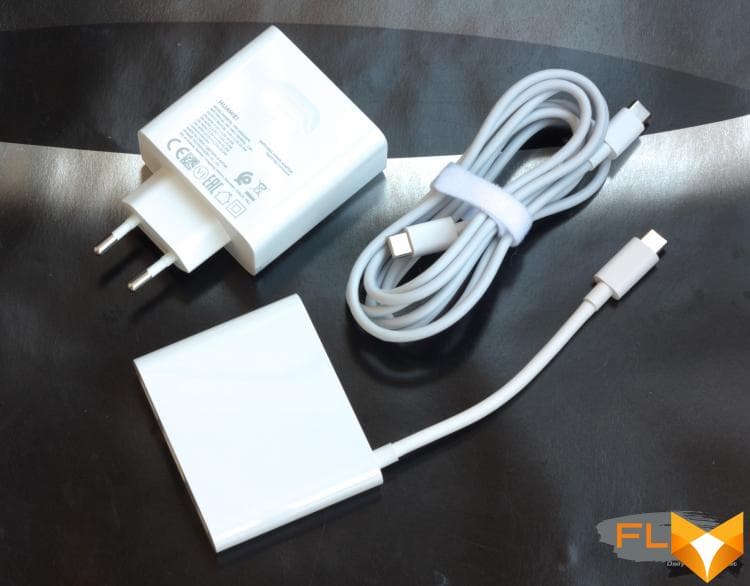
We saved the most exciting question for last: how good are the keyboard and touchpad? Contrary to all misgivings, we found the new MateBook’s manipulators to be remarkably good. Laying a solid foundation under the keys is already half the battle, but the MateBook 13 also has excellent mechanisms: not as elastic as, for example, the 16-inch MacBook Pro, but we would put an equal sign between the keyboards of the fresh MacBook Air and MateBook 13. The touchpad did not let us down either: the panel, covered with moderately tenacious and moderately smooth glass, guarantees perfect tracking of the cursor and is pressed with a pleasant tactile feedback.
The creators of the MateBook 13 moved the power button to the space in front of the screen hinges, thanks to which they managed to save the full width of the function keys and make room for the Del key. But this is not at all the main thing: HUAWEI was one of the first manufacturers after Apple to integrate a fingerprint scanner into the power button. The biometric sensor (either through the fault of Windows, or because of the imperfection of the device itself) turned out to be rather capricious during the initial setup, but then it recognizes the owner with every touch and works with lightning speed.

⇡#Internal design and upgrade options
Getting inside the laptop is not as easy as you might think, looking at the six screws with Torx-heads: one more screw is hidden under each rubber foot, which will first have to be peeled off. In addition, the bottom clings to the top of the case with several hooks, and in order to separate the two halves of the chassis and then return the bottom panel to its place, physical force is required, risking damage to the fasteners. However, MateBook 13 users do not need to do this at all. The RAM is soldered to the motherboard, and the SSD, although removable, is wrapped in a case that is pressed against the case wall through a thermal pad.
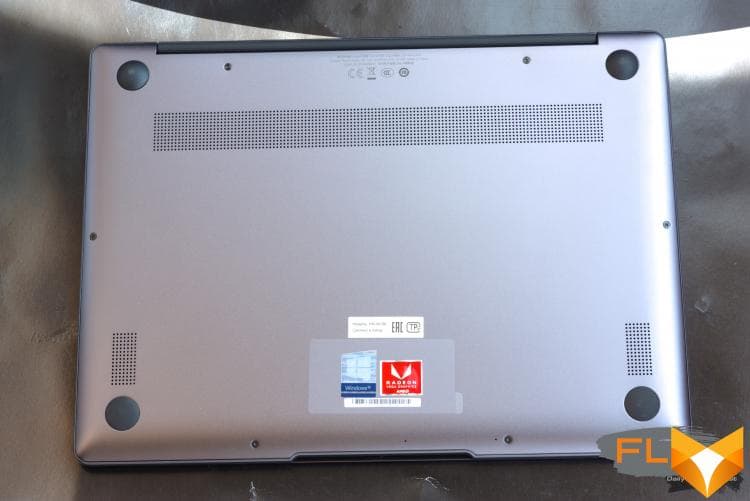
But it is immediately clear why the MateBook 13 weighs exactly 1.31 kg, and not less. The point is not only in the metal chassis, but also in the cooling system, which consists of a wide heat sink plate, two thick heat pipes and two tangential fans. The only pity is that due to the limited height of the case, it was impossible to place the cooler and SSD on top of the motherboard. As a result, there is not much room for the battery, and HUAWEI had to make do with a capacity of 41.8 Wh. There is another limitation: the Apple MacBook Air, of course, has a poor cooling system, but it will not work worse if you put the laptop on your knees, on a carpet or on another soft surface. But the MateBook 13’s cooler can be suffocated by accident, because it draws air through the mesh in the bottom panel.
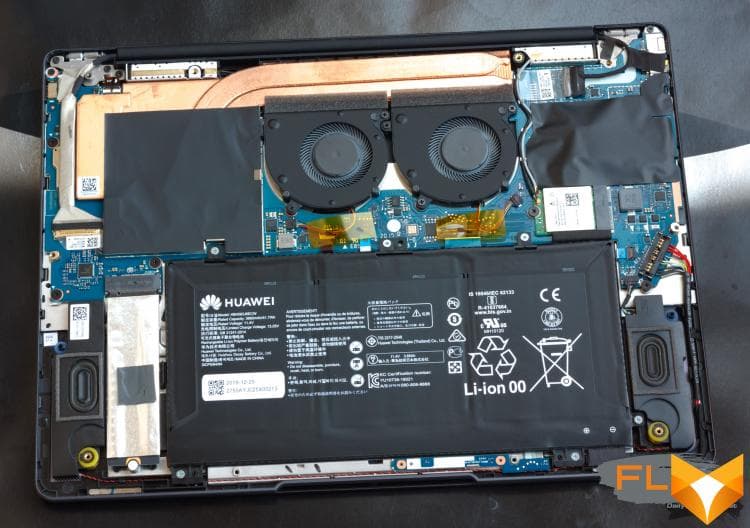
⇡#Testing Method
| Synthetic tests | |
|---|---|
| Application | Settings |
| 3DMark Time Spy | — |
| Geekbench 4 | — |
| CINEBENCH R20 | — |
| GFXBench 5 (Aztec Ruins — Normal Tier, High Tier) | Windows: Vulkan, macOS: Metal |
| fio 3.16 | Sequential Read/Write, Random Read/Write (Unbuffered I/O) |
| Work Applications | |||||
|---|---|---|---|---|---|
| Application | Benchmark | Settings | API | ||
| Intel Graphics | AMD Graphics | NVIDIA Graphics | |||
| Adobe Photoshop CC 2019 | PugetBench for Photoshop CC 0.8 (linked test structure) | Basic Benchmark | OpenGL + OpenCL + Metal (macOS) | OpenGL + OpenCL + Metal (macOS) | OpenGL + OpenCL |
| Adobe Photoshop Lightroom Classic CC 2020 | PugetBench for Lightroom Classic 0.8 (test structure at link) | — | DirectX 12 (Windows) | DirectX 12 (Windows) | DirectX 12 |
| Adobe Premiere Pro CC 2019 | PugetBench for Premiere Pro 0.8 (linked test structure) | Standard Benchmark | OpenCL (Windows)/Metal (macOS) | OpenCL (Windows)/Metal (macOS) | CUDA |
| Blender 2.81a | Class Room demo from Blender Foundation | Cycles renderer. Feature Set: Supported. Tile size: 32 × 32 (CPU) or 256 × 256 (GPU) | N/A (CPU rendering) | OpenCL | CUDA/OptX |
| AMD Nissan GTR Demo | Radeon ProRender | N/A | OpenCL | OpenCL | |
Display testing is performed using a Datacolor Spyder4 Elite colorimeter in ArgyllCMS and DisplayCAL 3 applications.
Notebook battery life is measured at a display brightness of 200 cd/m2in the following usage scenarios:
- web surfing: alternately opening and closing tabs of Computeruniverse.ru and Unsplash.com sites with an interval of 25 seconds in the Google Chrome browser (cache and cookies are disabled);
- Continuous playback of 4K HEVC (H.265) video.
⇡#Test Participants
The following devices took part in performance testing:
| Screen | CPU | RAM | GPU | SSD | HDD | Battery | |||
|---|---|---|---|---|---|---|---|---|---|
| HUAWEI MateBook 13 AMD (HN-W19R) | 13″, 2160 × 1440, IPS | AMD Ryzen 5 3500U | 4/8 cores/threads, 2.1-3.7GHz | DDR4 SDRAM, 3733 MT/s, 16 GB | Radeon Vega 8 | 1GB of system RAM | WD PC SN730 (PCIe 3.0 x4) 512GB | None | 41.8 Wh |
| Apple MacBook Air , Early 2020 (A2179) | 13.3”, 2560 × 1600, IPS | Intel Core i5-1030NG7 | 4/8 cores/threads, 1.1-3.5GHz | LPDDR4X SDRAM, 3733 MT/s, 8 GB | Intel Iris Plus Graphics G7 | 1.5GB of system RAM | Apple AP0512N (PCIe 3.0 x4) 512 GB | None | 49.9 Wh |
| Apple MacBook Pro 13.3″, Mid 2019 (A2159) | 13.3”, 2560 × 1600, IPS | Intel Core i5-8257U | 4/8 cores/threads, 1.4-3.9GHz | LPDDR3 SDRAM, 2133MHz, 16GB | Intel Iris Plus Graphics 645 | 128MB eDRAM | Apple AP1024N (PCIe 3.0 x4) 1024 GB | None | 58.2 Wh |
| ASUS ExpertBook B9 (B9450FA) | 14”, 1920 × 1080, IPS | Intel Core i7-10510U | 4/8 cores/threads, 1.8-4.9GHz | LPDDR3 SDRAM, 2133MHz, 16GB | Intel UHD Graphics 620 | ~1GB of system RAM | 2 × Samsung PM981 (PCIe 3.0 x4) 1024 GB | None | 66 Wh |
| ASUS VivoBook S14 (S433FL) | 14”, 1920 × 1080, IPS | Intel Core i7-10510U | 4/8 cores/threads, 1.8-4.9GHz | DDR4 SDRAM, 2666 MT/s, 16 GB | NVIDIA GeForce MX250 | 2GB GDDR5 | Samsung PM981 (PCIe 3.0 x4) 1024 GB | None | 50 Wh |
| ASUS ZenBook 14 (UX425JA) | 14”, 1920 × 1080, IPS | Intel Core i7-1035G7 | 4/8 cores/threads, 1.2-3.7GHz | LPDDR4X SDRAM, 3200 MT/s, 16 GB | Intel Iris Plus Graphics G7 | System RAM | Micron 2200 (PCIe 3.0 x4) 1024 GB | None | 67 Wh |
| MSI Prestige14 (A10SC) | 14”, 1920 × 1080, IPS | Intel Core i7-10710U | 6/12 cores/threads, 1.1-4.7GHz | LPDDR3 SDRAM, 2133MHz, 16GB | NVIDIA GeForce GTX 1650 Max-Q | 4GB GDDR6 | Samsung PM981 (PCIe 3.0 x4) 1024 GB | None | 52 Wh |
⇡#Screen Quality
The MateBook 13 screen is good with an extremely favorable 3:2 aspect ratio for a modest 13-inch diagonal and a high resolution of 2160 × 1440, but in other characteristics by which it is customary to evaluate the quality of the matrix, it makes a double impression. We must pay tribute to HUAWEI, the screen has a large margin of brightness – 349 cd / m2, especially important when the screen surface is glossy (and here it glares extremely strongly). While those numbers are certainly not a record compared to the best laptop panels, the smaller screens are dominated by the dimmer varieties. But the contrast level of 695:1 is, whatever one may say, a passed stage for IPS technology.
And yes, there is one caveat: the maximum brightness from the MateBook 13 can only be squeezed out when working on a wire, and in offline mode it automatically drops to 200 cd / m2. Without this limitation, as we will see as a result of battery tests, the novelty cannot do.
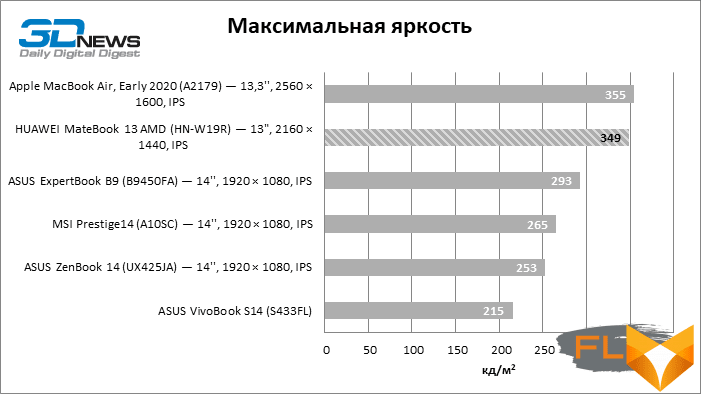
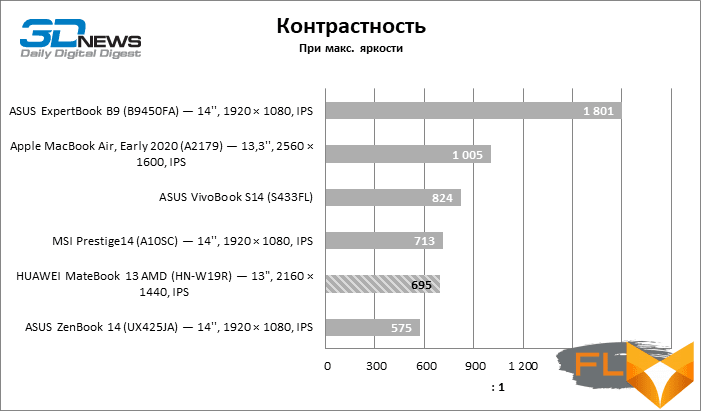
Another point: the high brightness in this case came at the cost of increasing the color temperature to about 7500 K. As a result, if the buyer of the MateBook 13 is going to use a laptop for serious work with photos, it will inevitably decrease as a result of calibration to the 6500 K standard, which will entail some loss of brightness.

Another defect that will have to be corrected with a colorimeter is the unfortunate gamma correction curve, which steals contrast in almost the entire tonal range.
 |
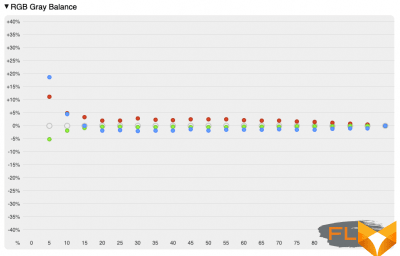 |
Finally, while the MateBook 13’s data sheet claims full coverage of the sRGB color space, in reality there is about a 5% undershoot in the greens area.
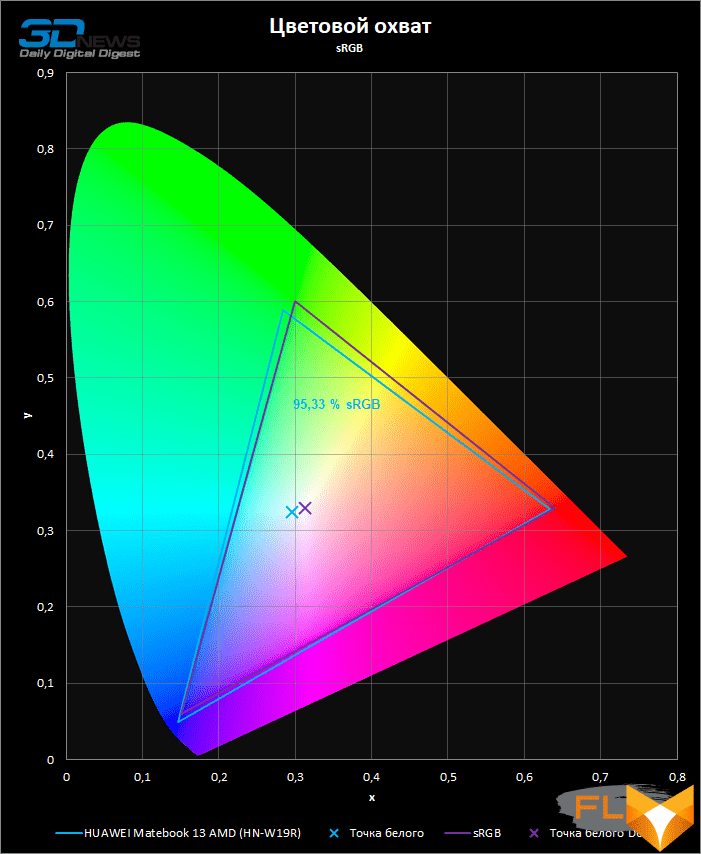
Fortunately, the color accuracy – adjusted for the shifted white point – can be considered quite satisfactory: the average deviation from the standard is 1.67 according to the Delta E 2000 criteria, and, of course, there are no problems such as strong edge flare or flickering of the panel noticeable to the naked eye at low brightness setting.
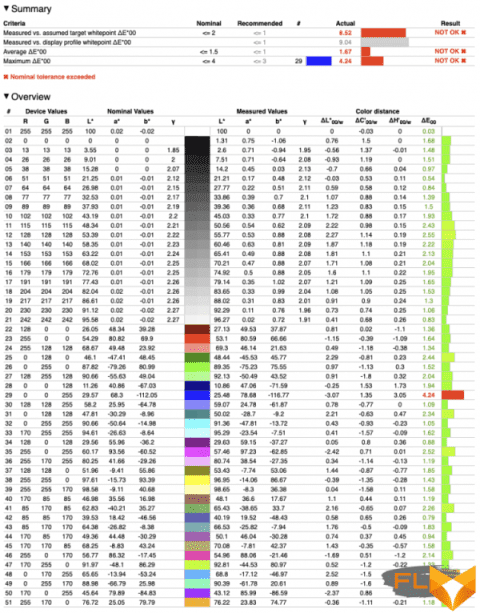
⇡#Clock speeds, temperature and noise level
The HUAWEI MateBook 13 series laptops are original devices in every way, but the AMD MateBook 13 model differs from most similar machines in the hardware platform. It is all the more interesting to find out how good AMD Ryzen chips are in the niche of ultra-compact laptops that is still uncharacteristic for them. The only pity is that HUAWEI did not have time to put the latest 7nm 4000-series processors into action and is forced to use the Ryzen 5 3500U quad-core processor based on the Zen + architecture and the 12nm process technology.
The CPU here runs within the standard 15W power headroom and develops about the same clock speeds (about 2.6 GHz) under load as Intel’s 10th generation chips of the same power consumption. However, it should be noted that the ratio of the number of megahertz per watt is still in favor of AMD. In addition, the power balance between the CPU cores and the Radeon Vega 8 integrated graphics is tuned in such a way that when both components are loaded at the same time, the GPU drops the frequency more, leaving room for the CPU to auto-overclock, and this is perhaps the best solution with such a limited overall headroom.
| Load Clock | ||||||||
|---|---|---|---|---|---|---|---|---|
| Cinebench R20 (Max Thread #) | LuxMark 3.1 | Cinebench R20 (Max Thread #) + LuxMark 3.1 | ||||||
| CPU clock speed, MHz | GPU clock speed, MHz | CPU clock speed, MHz | GPU clock speed, MHz | |||||
| Medium | Max | Medium | Max | Medium | Max | Medium | Max | |
| HUAWEI MateBook 13 AMD (HN-W19R) – AMD Ryzen 5 3500U / AMD Radeon Vega 8 | 2534 | 3147 | 1017 | 1066 | 1830 | 1958 | 383 | 650 |
| Apple MacBook Air, Early 2020 (A2179) – Intel Core i5-1030NG7 / Intel Iris Plus Graphics G7 | 1479 | 1511 | 651 | 700 | 995 | 1025 | 300 | 350 |
| ASUS ExpertBook B9 (B9450FA) — Intel Core i7-10510U / Intel UHD Graphics 620 — Auto | 1813 | 1900 | 671 | 750 | 866 | 900 | 508 | 550 |
| ASUS VivoBook S14 (S433FL) — Intel Core i7-10510U / NVIDIA GeForce MX250 | 2555 | 3392 | 1550 | 1695 | 1804 | 2294 | 1248 | 1683 |
| ASUS ZenBook 14 (UX425JA) — Intel Core i7-1035G7 / Intel Iris Plus Graphics G7 — Auto | 2024 | 2195 | 876 | 948 | 1153 | 1297 | 654 | 699 |
| CPU and GPU power | ||||||||
|---|---|---|---|---|---|---|---|---|
| Cinebench R20 (Max Thread #) | LuxMark 3.1 | Cinebench R20 (Max Thread #) + LuxMark 3.1 | ||||||
| CPU power consumption, W | GPU power consumption, W | CPU power consumption, W | GPU power consumption, W | |||||
| Medium | Max | Medium | Max | Medium | Max | Medium | Max | |
| HUAWEI MateBook 13 AMD (HN-W19R) – AMD Ryzen 5 3500U / AMD Radeon Vega 8 | 15 | 17 | 15 | 15 | 15 | 15 | 15 | 15 |
| Apple MacBook Air, Early 2020 (A2179) – Intel Core i5-1030NG7 / Intel Iris Plus Graphics G7 | 10 | 10 | 10 | 10 | 10 | 10 | 10 | 10 |
| ASUS ExpertBook B9 (B9450FA) – Intel Core i7-10510U / Intel UHD Graphics 620 – Auto | 10 | 11 | 8 | 9 | 8 | 9 | 8 | 9 |
| ASUS VivoBook S14 (S433FL) – Intel Core i7-10510U / NVIDIA GeForce MX250 | 19 | 28 | N/A | N/A | 13 | 15 | N/A | N/A |
| ASUS ZenBook 14 (UX425JA) — Intel Core i7-1035G7 / Intel Iris Plus Graphics G7 — Auto | 14 | 15 | 14 | 14 | 13 | 14 | 13 | 14 |
Прим. The measurement is performed after the device has warmed up and all parameters have stabilized.
Be that as it may, even 15 watts can be a problem for the cooling system when it comes to devices as thin and compact as the MateBook 13 (and some, like the MacBook Air, find it difficult to cope with 10 watts). But not at this time. The MateBook 13’s dual turbine design prevents the CPU from reaching temperatures above 75°C while maintaining a moderate noise level of 38dBA, and when the system is idle, it’s completely inaudible. With a load on the GPU or on the CPU and GPU at the same time, the novelty is already quite loud, although, judging by the heating of the SoC, there is no great need to drive the fans at high speeds. In addition, the cramped chassis with a 13-inch screen still imposes its own limitations on heat dissipation, and the fact that AMD’s MateBook 13 makes more noise in a stress test than its 14-inch counterparts is neither surprising nor indignant.
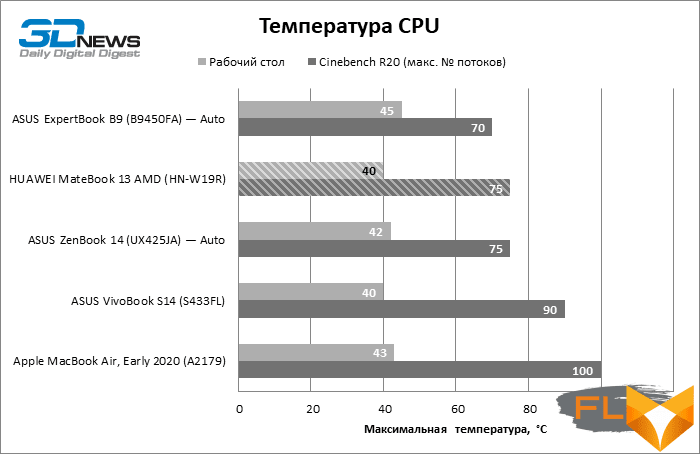
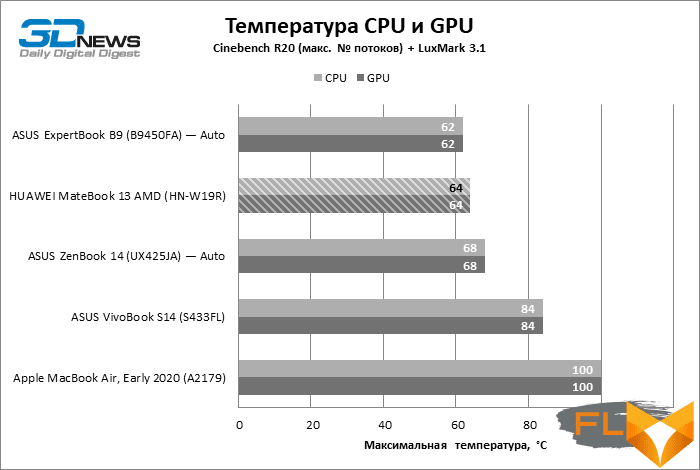
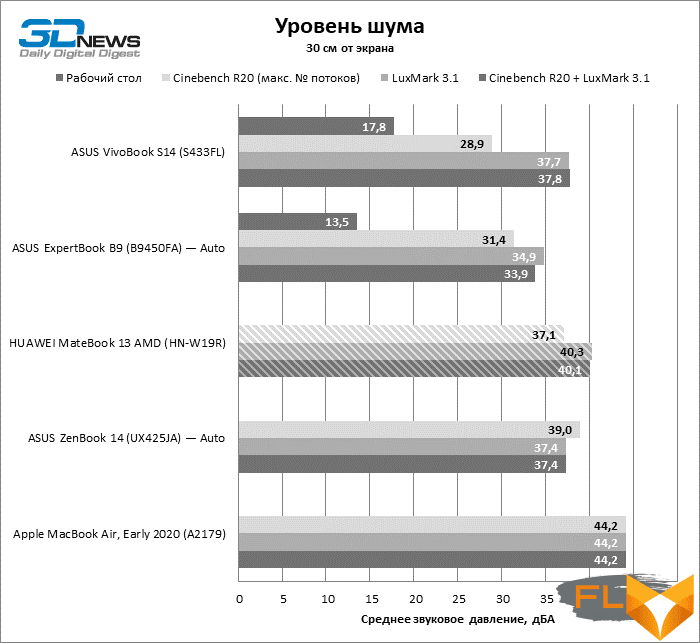
⇡#Synthetic performance tests
Even though the Ryzen 5 3500U processor runs at higher clock speeds than Intel’s similarly power-hungry offerings, it scores lower in the Geekbench synthetic benchmark than the competitor’s more economical chips (especially in single-threaded mode). However, Geekbench uses load patterns that are too short to demonstrate CPU capabilities under real power and temperature limits. The Cinebench R20 test, which takes a long time on four low-wattage cores, placed AMD’s MateBook 13 in its rightful place between laptops based on the Intel platform with processor TDPs of 10 and 20W, respectively.
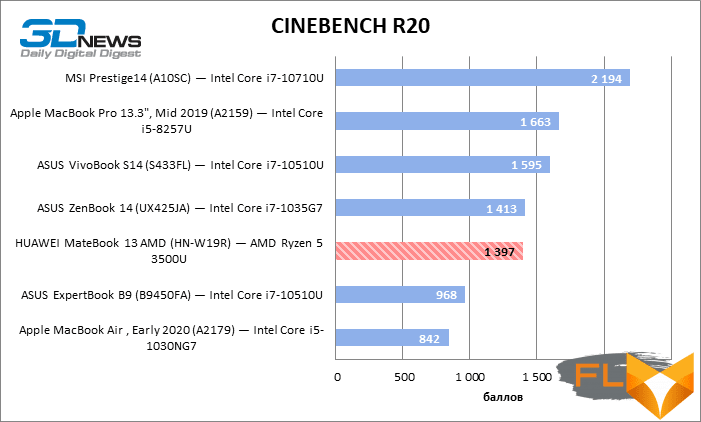
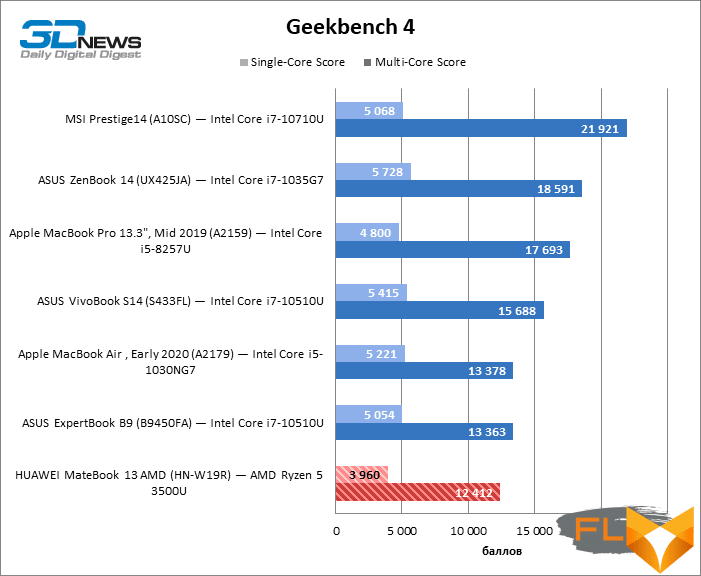
But the Radeon Vega 8 graphics core unequivocally outperforms the graphics that Intel builds into its 10th generation Core mobile processors on 14nm Comet Lake crystals. The Vega 8’s counterpart in terms of speed is the Iris Plus video adapters with a block of high-speed discrete memory eDRAM, which Intel used in the now obsolete 8000-series models, and the slightly faster Iris Plus G7 components of the latest Ice Lake chips. Of course, the integrated graphics of the Ryzen 5 3500U are not a gaming-grade solution, and the MateBook 13 laptop itself is clearly not designed for games, but those work applications that a low-wattage quad-core CPU can do will benefit from a good graphics processor.
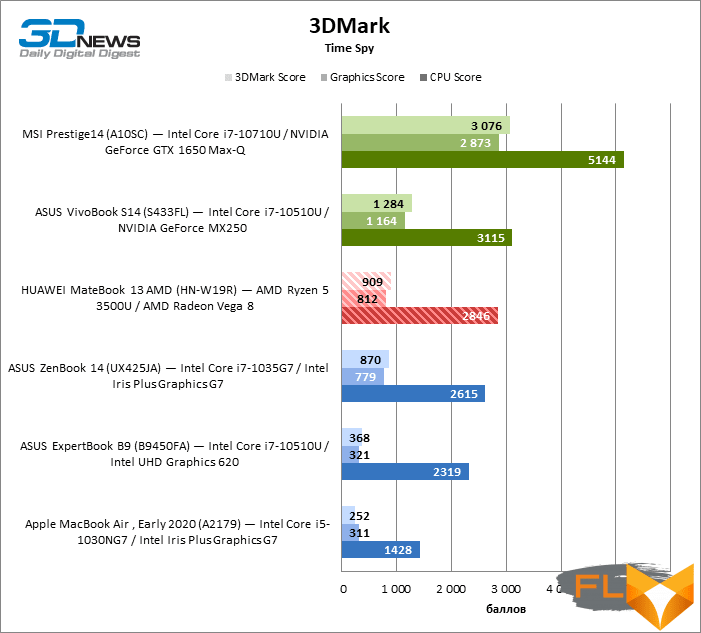
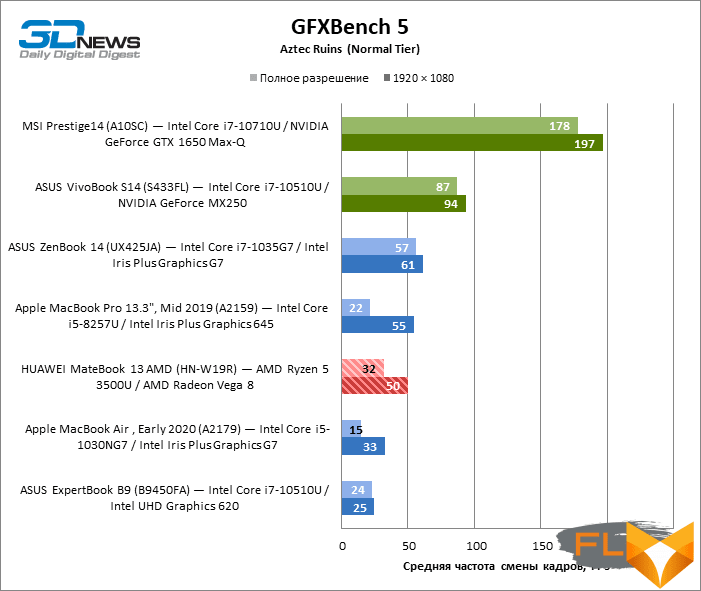
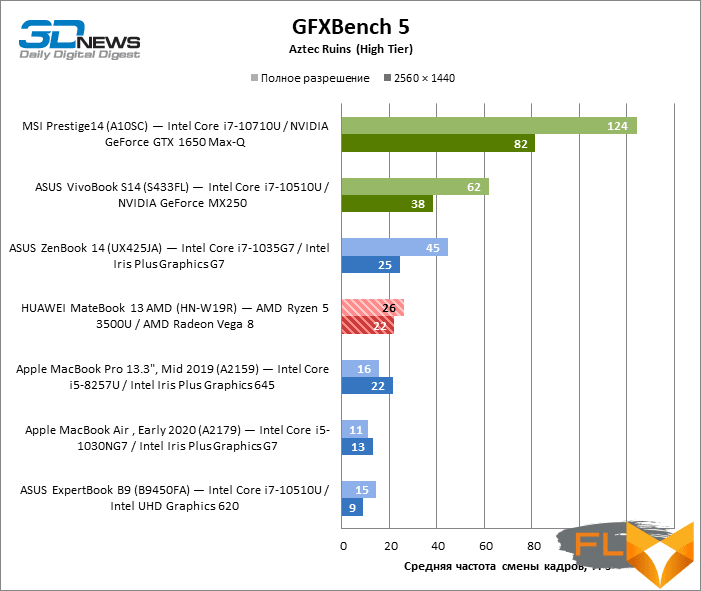
⇡#Performance in production applications
The Blender benchmark on the Cycles engine is optimistic about the performance of the Ryzen 5 3500U chip, which, when rendered with four processor cores with a total SoC power of 15W, finished faster than a 20W Intel competitor, not to mention 10W CPUs. And the Radeon Vega 8 graphics, as you would expect from the GCN architecture, are excellent in general-purpose calculations. It is valuable at least that Vega 8 is compatible with programs that refuse to use the integrated Intel video core under the OpenCL API. But, as it turned out, the performance of the integrated video adapter Ryzen 5 3500U with the proper level of software optimization (as in rendering on the Radeon ProRender engine) is quite comparable to the results of entry-level discrete GPUs.


Unlike ray tracers, which perfectly parallelize the workload across four cores and eight threads, Adobe Lightroom appreciates high single-threaded performance, which is not a strength of the Zen + architecture. As a result, passive photo editor operations (importing photos, applying filters, and so on) are much faster on low-wattage Intel chips than on the Ryzen 5 3500U. But in active tasks, the MateBook 13 AMD performs no worse than some of the “thick” ultrabooks with a discrete graphics core.
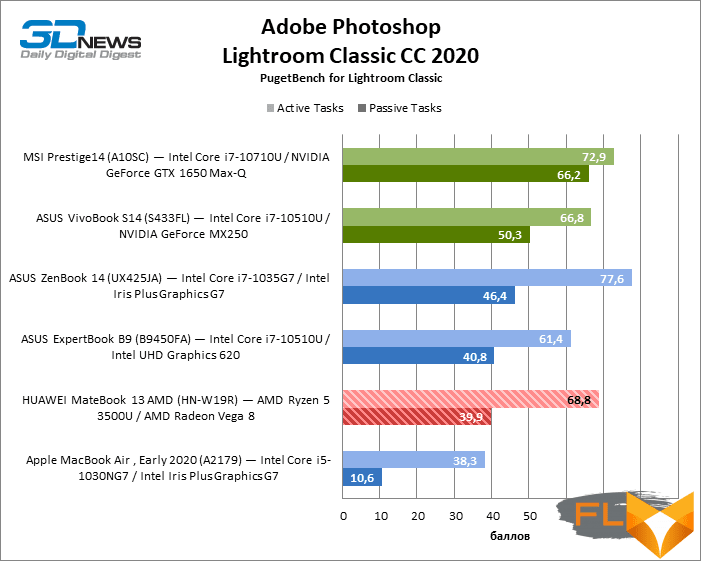
Note Scores are calculated as a percentage of Intel Reference Workstation performance Core i9-9900K, NVIDIA GeForce RTX 2080, 64GB RAM.
The results of the Photoshop benchmarks summarize our previous observations: the 15W Ryzen 5 3500U chip is once again forced to contend with Intel’s 10W SoCs, but the Radeon Vega 8 graphics did their job just as well as discrete solutions in the GeForce MX250 class.
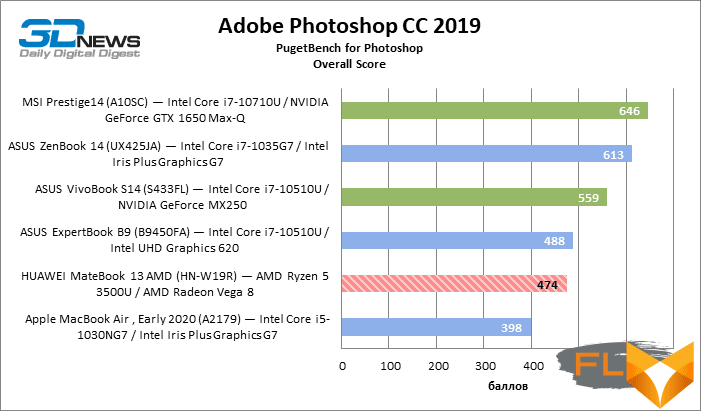
Note Scores are calculated as a percentage of Intel Reference Workstation performance Core i9-9900K, NVIDIA GeForce RTX 2080 and 64GB RAM x 10.
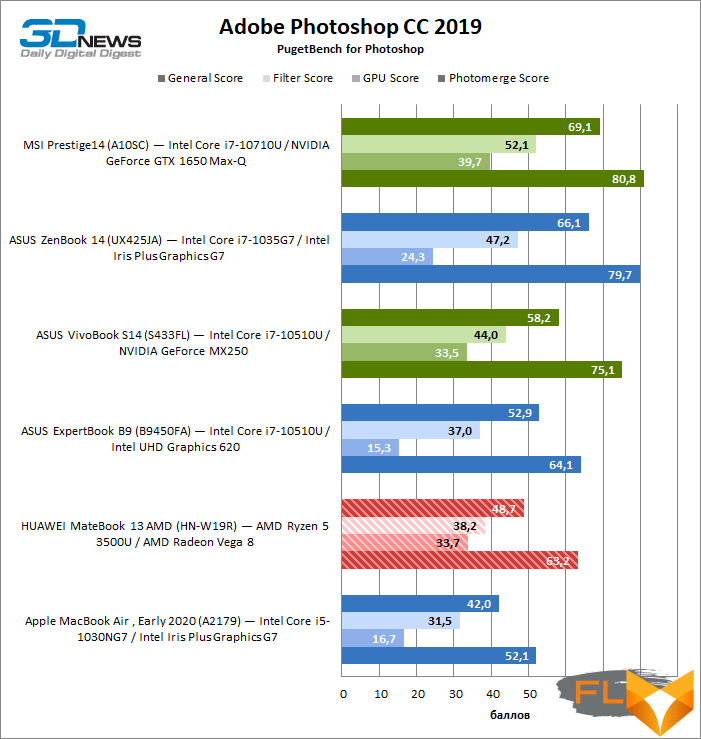
Note Scores are calculated as a percentage of Intel Reference Workstation performance Core i9-9900K, NVIDIA GeForce RTX 2080, 64GB RAM.
The test results in Premiere Pro once again tip the scales in favor of the MateBook 13 AMD and the “red” platform. Here, the Intel chips outperform the Ryzen 5 3500U in a GPU-friendly workload, only due to the increased headroom. The only pity is that the HUAWEI laptop will now have to compete in the market not only with those products that are equipped with 14nm Intel silicon, but also with fresh Ice Lake chips, and they are already at least as fast as the Ryzen 5 3500U in terms of speed, while consuming less energy.
Be that as it may, Premiere Pro in our selection of work applications is an optional program for any ultrabooks (especially such compact ones), but in relation to the MateBook 13 there is a practically significant conclusion: if you lower the resolution in the viewport to ¼ of the original and not get carried away by demanding effects, this machine is quite suitable for editing 4K projects with a frame rate of 24 Hz. Processing effects dependent on the performance of the GPU, Intel’s integrated graphics, not to mention discrete video adapters, copes unparalleledly better than the Radeon Vega 8, but this is probably due to the way AMD logic distributes power between the CPU and GPU cores under heavy load on one or another SoC component. Fortunately, the installation of such projects is in any case strictly contraindicated for laptops without a discrete video adapter.
|
 |
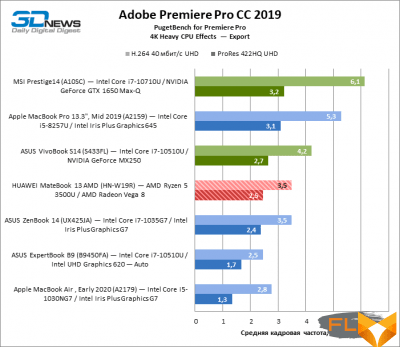 |
|
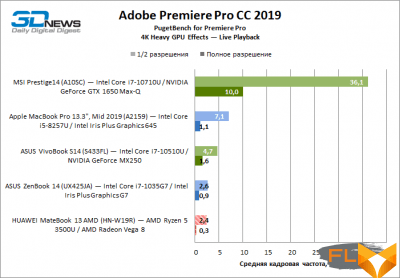 |
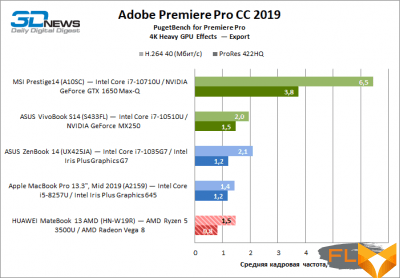 |
⇡#SSD Performance
Our copy of the AMD MateBook 13 has a Western Digital SN PC730 SSD connected to the SoC with four PCI Express 3.0 lanes. We’ve been seeing more Samsung products in laptops lately, but WD’s solid-state by and large matches the extremely common Korean PM981 in almost every aspect of performance. Even though 512 GB limits the bandwidth of modern SSDs equipped with capacious Flash memory chips.
|
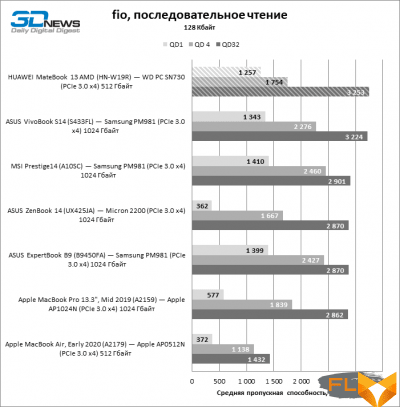 |
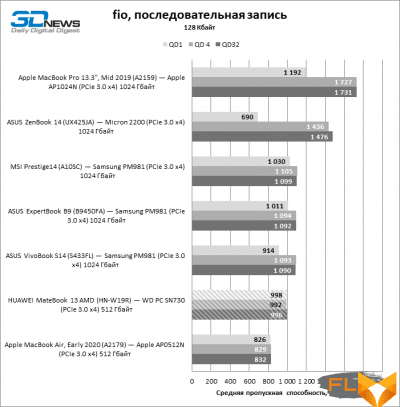 |
|
 |
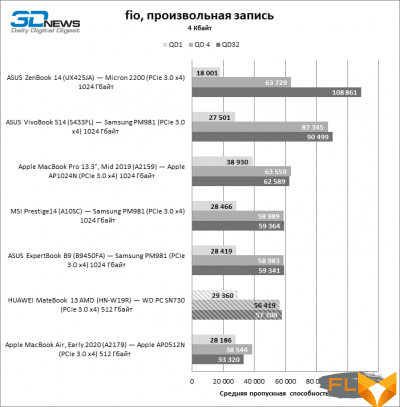 |
⇡#Battery life
The HUAWEI MateBook 13 AMD is faster than most of the ultra-compact laptops on Intel CPUs that we have studied recently, but a powerful CPU deserves a capacious battery, for which there was simply no place inside a thin case. We’ll have to “put out the lights” after four hours of web surfing or watching movies on the HUAWEI MateBook 13 AMD screen at moderate brightness.
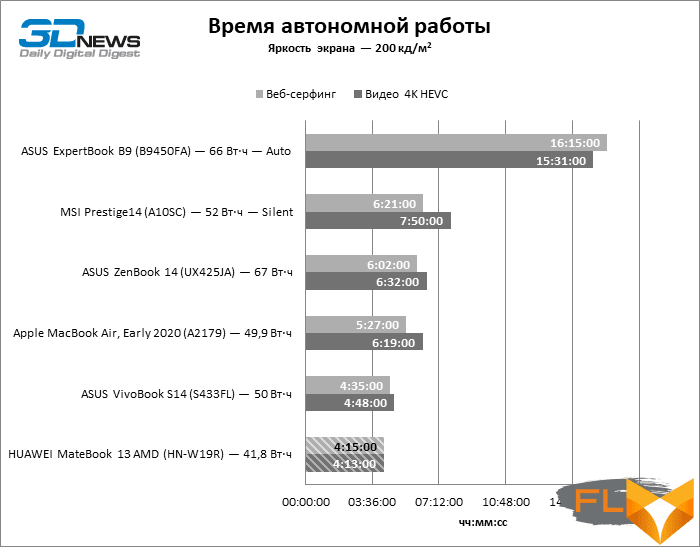
⇡#Conclusions
In everything related to the MateBook 13 (be it the version with an AMD Ryzen chip or other models of the same series on Intel CPUs), there is no escape from the comparison with the MacBook Air, which inspired the creators of the novelty. And, you know, in many respects, the HUAWEI product is at least as good as its prototype, and it is precisely in those aspects that Apple technology is especially strong in. If you close your eyes to such a trifle as too tight hinges, the mechanics of the MateBook 13 are almost flawless. Both the MacBook Air and MateBook aren’t really the most airy laptops in their class. But their cases are quite rigid in the place where it is especially important – under the keyboard. And you can’t find fault with the MateBook 13 keyboard itself, and the touchpad is almost the best with which we have dealt so far, excluding, again, Apple’s buttonless touchpads. Add to that the biometric sensor integrated into the power button, another valuable feature that the MateBook has borrowed from the MacBook while other manufacturers are somehow shy.
Convenience and ergonomics are already half of what is required from an ultrabook, which, in fact, is a lightweight “typewriter”. And even more so for the money that a HUAWEI product costs. The next item is the screen, but in this regard, the MateBook 13 AMD left mixed impressions: with all the attention to detail, it is strange that he chose such a rare matrix with a high resolution and a 3:2 aspect ratio, just perfect for this form factor, but completely didn’t care about setting it up. Finally, the small size and light weight alone aren’t worth much without the ability to run the battery for a long time, but AMD’s MateBook 13 didn’t do well with that. It is also poorly adapted to settled life – there are not enough ports and there is no support for the Thunderbolt 3 interface that saves in such cases. Alas, the ideal was so close …
However, let’s end this review on a positive note. Unfortunately, we did not get a rare opportunity to compare Intel and AMD mobile processors in the same chassis, and we will not say anything about Intel’s MateBook 13 variety. In addition, the HUAWEI laptop hit the market at a bad time, when the next generation of low-wattage Ryzen chips. But AMD’s MateBook 13 already aims to be a speed leader among truly compact laptops. Or, on the contrary, this is one of the smallest models with a good quad-core CPU, suitable not only for passive consumption of content, but also for moderately demanding work tasks.
FAQ Huawei matebook 13 amd (hn-w19r)
What is the global warranty policy for the Huawei MateBook 13 HN-W19R?
The global warranty policy for the Huawei MateBook 13 HN-W19R typically includes a 12-months warranty, but may vary based on the seller and region. It’s important to check the specific terms and conditions for the region of purchase.
Can you describe the Huawei MateBook 13 2021’s specification?
The Huawei MateBook 13 2021 features an 8GB RAM, a high-resolution display, Huawei Share for multi-screen collaboration, and is powered by a high-performance processor. It also includes USB-C ports and supports Huawei’s ecosystem for a better user experience.
Huawei Share on the MateBook 13 allows for seamless multi-screen collaboration between the laptop and a Huawei smartphone, facilitating easy file transfers, screen mirroring, and efficient workflow between devices.
What should buyers look for in the item description when purchasing a Huawei MateBook?
When purchasing a Huawei MateBook, buyers should check the item description for key specifications like processor type, RAM, storage capacity, and any additional features like Huawei Share or USB-C connectivity.
How does the MateBook’s USB-C port benefit users?
The USB-C port on the MateBook provides versatile connectivity options, including fast data transfer with USB 3.1 Gen1, charging, and connecting to external displays or devices.
What should customers know about the seller’s refund and return policy in the EU?
Customers in the EU should review the seller’s refund and return policy, which is regulated by EU consumer laws, ensuring compliance with standard practices. This information is usually available in the item description or the seller’s website.
How can users access Huawei’s cloud services on the MateBook?
Users can access Huawei’s cloud services on the MateBook by registering for an account, often through a pre-installed app or by clicking the link to Huawei’s cloud service. This offers additional storage and synchronization options.
Is there a Huawei smartphone app for managing the MateBook?
Yes, Huawei provides smartphone apps that allow users to manage and interact with their MateBook for tasks like file transfers, multi-screen collaboration, and accessing Huawei cloud services.
How do privacy policies impact the use of Huawei MateBook in Australia?
In Australia, the use of Huawei MateBook and its associated services like Huawei Share and cloud storage are subject to Huawei’s privacy policy, which complies with local data protection and privacy regulations.
What are the warranty terms for the Huawei MateBook in the Republic of Ireland?
In the Republic of Ireland, the Huawei MateBook typically comes with a 12-months warranty, but this may vary depending on the seller and specific regulations in the country. It’s advisable to make an enquiry with the seller or check the product description for detailed warranty information.

